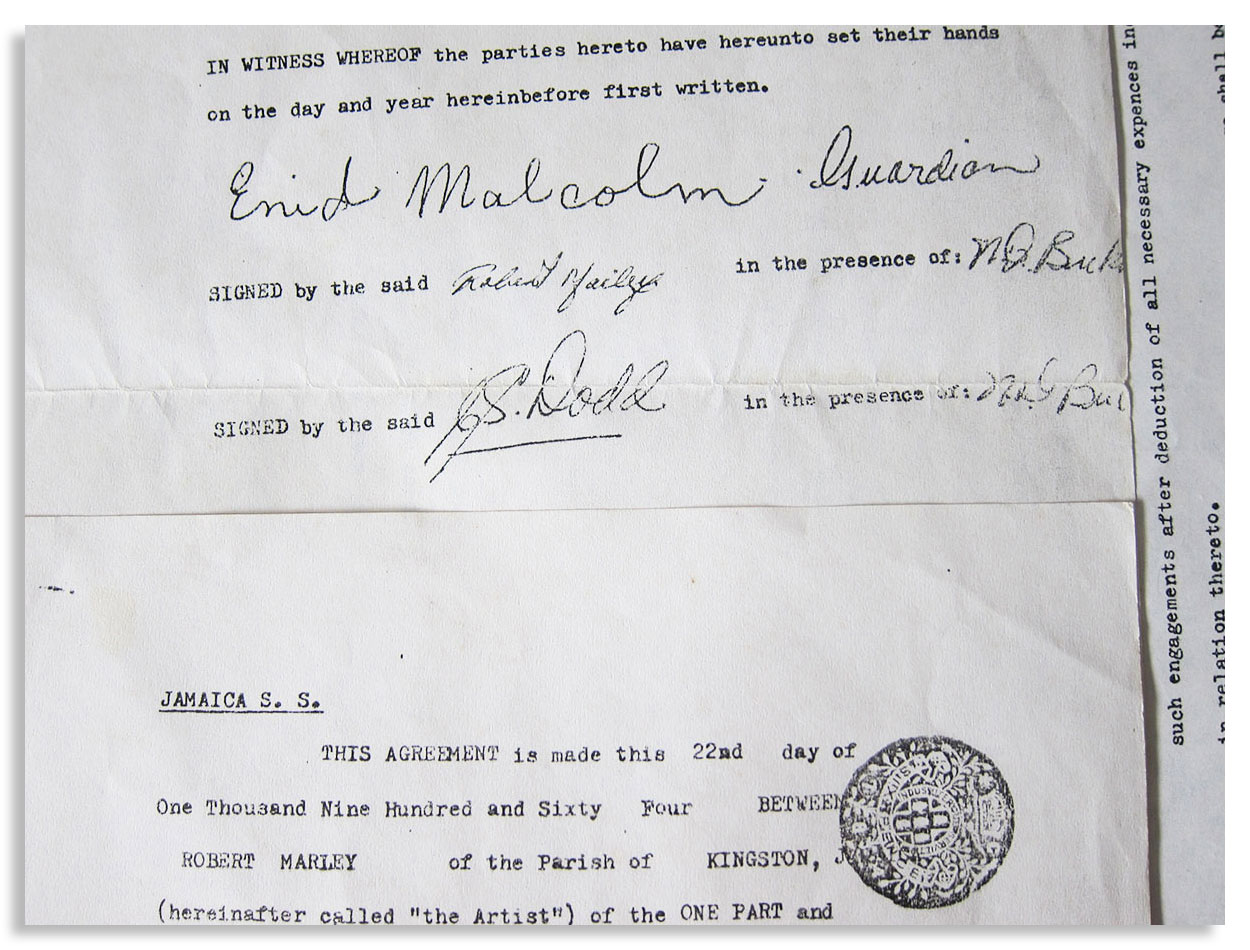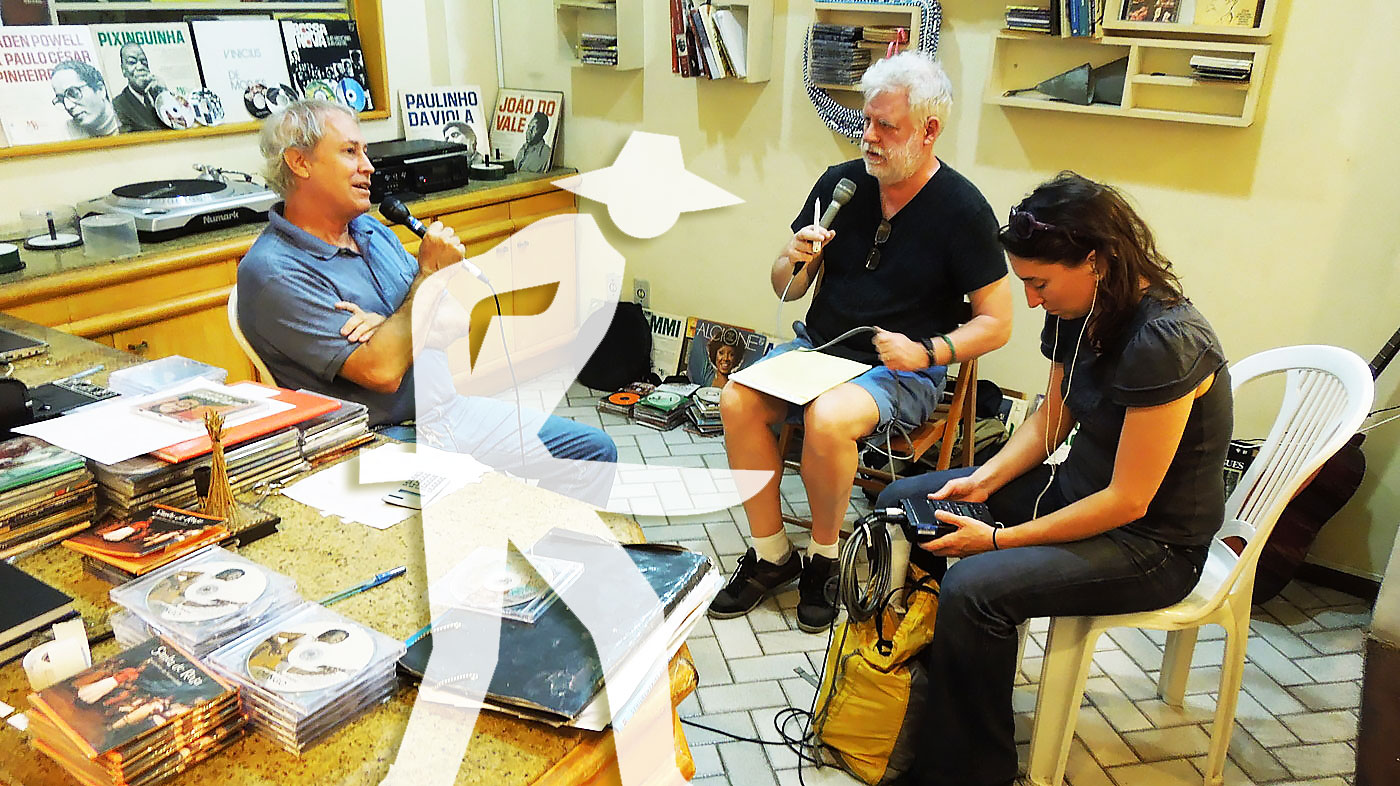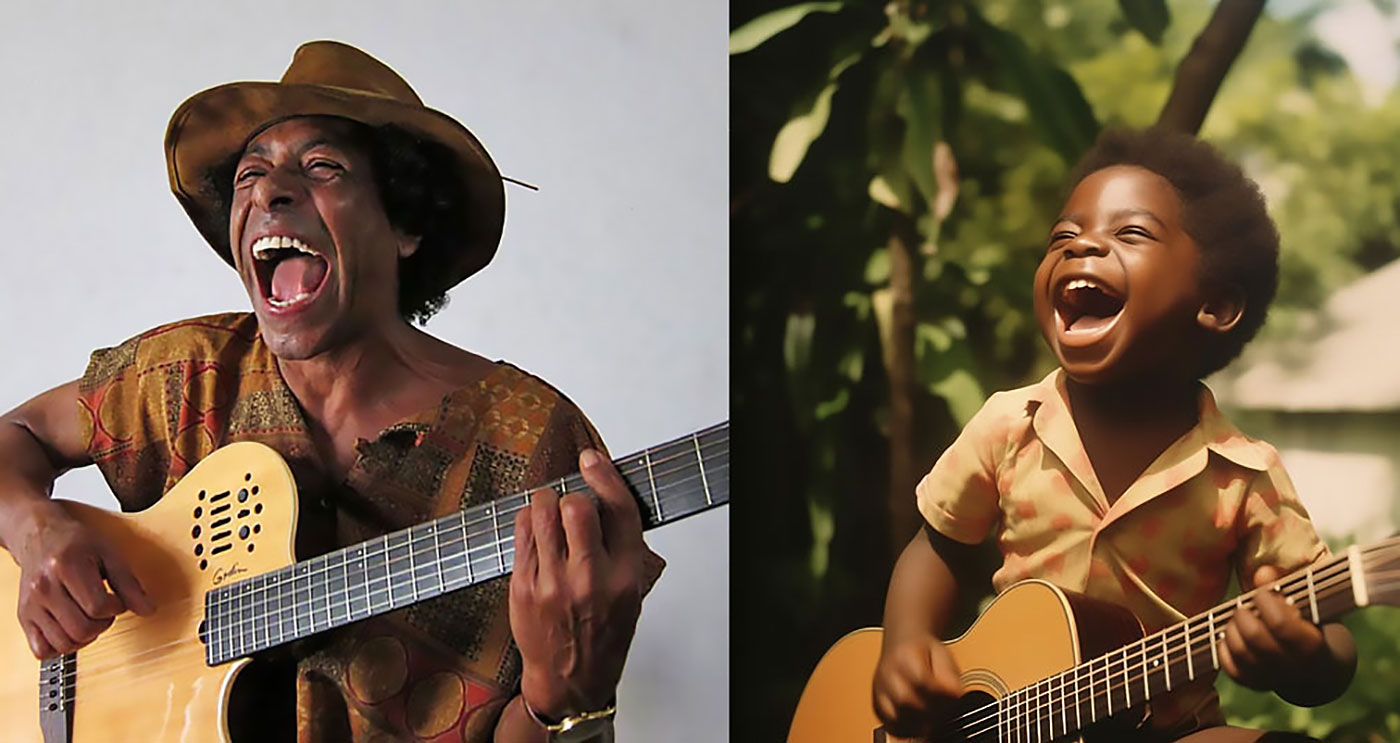What do Jimmy Cliff, Jimmy Page, and Dionne Warwick all have in common? For one thing, they've all lived in Bahia. And so have, and do, untold numbers of other wonderful creators whose magisterial work has never reached beyond very limited surroundings. That's why all this began. If all creators can potentially have global reach, Bahian creators can too.

In this matrix it's not which pill you take, it's which pathways you take, pathways originating in the sprawling cultural matrix of Brazil: Indigenous, African, Sephardic and then Ashkenazic, European, Asian... Ground Zero is the Recôncavo, delineated by the Bay of All Saints, earthly center of gravity for the disembarkation of enslaved human beings — and the sublimity they created — presided over by the ineffable Black Rome of Brazil: Salvador da Bahia.
("Black Rome" is an appellation per Caetano Veloso, son of the Recôncavo, via Mãe Aninha of Ilê Axé Opô Afonjá.)
CURATION
- from this page: by Matrix
Network Node
- Name: Marcelo Caldi
- City/Place: Rio de Janeiro
- Country: Brazil
Life & Work
-
Bio:
By breaking the barriers between different landscapes of music, bringing the Argentine Tango and the Brazilian forró closer together and performing as a singer and instrumentalist, besides being a composer and arranger for symphonic music, Marcelo Caldi has become one of the most brilliant and accomplished musicians of his generation. He has contributed greatly to the resurgence of the accordion in the contemporary music scene in Brazil, and is the author of the book “Tem Sanfona no Choro” (There is accordion in the Choro), which includes a homonym album. Released in 2012 by Moreira Salles Institute in partnership with Funarte (Luiz Gonzaga Centenary Award), the book recovers an unpublished material: the music sheets of the choros from Luiz Gonzaga’s early work.
Marcelo has toured with the show “Marcelo Caldi Trio” through Brazil and Portugal, performing original songs such as the forró “Lembrei do Ceará”. The song is part of the album “Forró e Choro Vol. 1” (in partnership with Fabio Luna), relaunched in 2013 by Mills Records, and nominated to the 2009 Brazilian Music Award in the instrumental category. Other titles include “Cantado” (MP,B, 2009), “Nesse tempo” (Delira, 2006) and “Intrometidos” (with Alexandre Caldi, Independent, 2003).
The musician has also arranged songs performed by the Petrobras Symphonic Orchestra, the Barra Mansa Symphonic Orchestra and the Recife Symphonic Orchestra (the last two had renowed singer Elba Ramalho participation as a special guest), in honor to Luiz Gonzaga. In the concerts alongside Petrobras Symphonic Orchestra and Recife Symphonic Orchestra, Caldi performed Sivuca’s songs to accordion and orchestra: “Rapsódia gonzaguena” and “Concerto sinfônico para Asa branca”.
In 2013, Caldi shared the stage with Gilberto Gil and Pro Arte Orchestra at MIMO Festival, performing in Ouro Preto e Olinda. He also wrote arrangements for the Young Orchestra of Paquetá and composed a song for the Radamés Gnattali Quartet. In the same year, he wrote marchinha arrangements for the Petrobras Symphonic Orchestra and the group Monobloco, in addition to composing a tribute to Dorival Caymmi for the Bahia Symphonic Orchestra. In October of 2014, Marcelo was the soloist of Radamés Gnattali’s “Concerto para acordeom, orquestra de cordas e tumbadoras”, performed alongside the Federal University of Fluminense Symphonic Orchestra.
Ao romper barreiras entre diferentes paisagens da música, aproximar o tango argentino do forró brasileiro e se apresentar como cantor e instrumentista, além de compositor e arranjador sinfônico, Marcelo Caldi se tornou um dos músicos mais completos de sua geração. É um dos responsáveis pela revitalização da sanfona no cenário contemporâneo, autor do livro “Tem sanfona no choro”, que inclui CD homônimo, lançado em 2012 pelo Instituto Moreira Salles, em parceria com a Funarte (Prêmio Centenário de Luiz Gonzaga), em que resgata um material inédito, as partituras de choros da primeira fase do rei do baião.
Compôs arranjos sinfônicos cantados por Elba Ramalho e interpretados pela Orquestra Petrobras Sinfônica, Orquestra Sinfônica de Barra Mansa e Orquestra Sinfônica do Recife, em homeagem a Luiz Gonzaga.
Nos concertos com a Petrobras Sinfônica e a Sinfônica do Recife, Caldi interpretou peças de Sivuca para sanfona e orquestra, “Rapsódia gonzaguena” e “Concerto sinfônico para Asa branca”. Foi o solista do “Concerto para acordeom, orquestra de cordas e tumbadoras”, de Radamés Gnattali, junto com a Orquestra Sinfônica da Universidade Federal Fluminense, em 2014.
Compôs uma peça sinfônica inédita para Orquestra Petrobras Sinfônica, em homenagem aos 450 anos do Rio de Janeiro, chamada “Alma carioca”, interpretada pela primeira vez na estreia da temporada de 2015, no Theatro Municipal do Rio de Janeiro.
Com o show Marcelo Caldi Trio, excursionou pelo Brasil e Portugal, mostrando canções de autoria própria, como o forró “Lembrei do Ceará”. A música está no disco “Forró e Choro Vol. 1” (com Fábio Luna), relançando em 2013 pela Mills Records, e indicado ao Prêmio de Música Brasileira 2009 na categoria instrumental. Lançou ainda os discos “Cantado” (MP,B, 2009), “Nesse tempo” (Delira, 2006) e “Intrometidos” (com Alexandre Caldi, independente, 2003).
Em 2013, subiu ao palco ao lado de Gilberto Gil e Orquestra Pro Arte na MIMO, em Ouro Preto e Olinda. Também criou arranjos para Orquestra Jovem Paquetá e uma composição para o Quarteto Radamés Gnattali. Em 2014, compôs arranjos de marchinhas para Orquestra Petrobras Sinfônica e Monobloco e uma homenagem a Dorival Caymmi para Orquestra Sinfônica da Bahia.
Contact Information
- Email: [email protected]
-
Management/Booking:
Produção Executiva
Fernando Gasparini
(21) 3596-6228
(21) 9 9930-6228
Media | Markets
- ▶ Twitter: marcelocaldi
- ▶ Instagram: marcelocaldi
- ▶ Website: http://marcelocaldi.com
- ▶ YouTube Channel: http://www.youtube.com/c/MarceloCaldi
- ▶ YouTube Music: http://music.youtube.com/channel/UC3FBNhEyNh1trzGKAe4KWag
- ▶ Spotify: http://open.spotify.com/album/7KSQFuUVt8liqFtRvssOrs
- ▶ Spotify 2: http://open.spotify.com/album/3Xqa2mTQkaszwbE1Ch0XF3
- ▶ Spotify 3: http://open.spotify.com/album/33bKtDEH6ZvBEnyD4bC78z
- ▶ Spotify 4: http://open.spotify.com/album/6cF5L20WY57FYBzghf82bl
- ▶ Spotify 5: http://open.spotify.com/album/4Vd08Zr7DSna71fMXIG9aZ
- ▶ Spotify 6: http://open.spotify.com/album/0hdY2j95I4gDeM6TmIBpif
Clips (more may be added)
"Dear Sparrow: I am thrilled to receive your email! Thank you for including me in this wonderful matrix."
—Susan Rogers: Personal recording engineer for Prince, inc. "Purple Rain", "Sign o' the Times", "Around the World in a Day"... Director of the Berklee Music Perception and Cognition Laboratory
"Thanks! It looks great!....I didn't write 'Cantaloupe Island' though...Herbie Hancock did! Great Page though, well done! best, Randy"
"We appreciate you including Kamasi in the matrix, Sparrow."
—Banch Abegaze: manager, Kamasi Washington
"This is super impressive work ! Congratulations ! Thanks for including me :)))"
—Clarice Assad: Pianist and composer with works performed by Yo Yo Ma and orchestras around the world
"Dear Sparrow, Many thanks for this – I am touched!"
—Julian Lloyd-Webber: UK's premier cellist; brother of Andrew Lloyd Webber (Evita, Jesus Christ Superstar, Cats, Phantom of the Opera...)
"Thanks, this is a brilliant idea!!"
—Alicia Svigals: World's premier klezmer violinist
Developed here in the Historic Center of Salvador da Bahia ↓ .
![]() Bule Bule (Assis Valente)
Bule Bule (Assis Valente)
"♫ The time has come for these bronzed people to show their value..."
Production: Betão Aguiar
MATRIX MODUS OPERANDI
Recommend somebody and you will appear on that person's page. Somebody recommends you and they will appear on your page.
Both pulled by the inexorable mathematical gravity of the small world phenomenon to within range of everybody inside.
And by logical extension, to within range of all humanity outside as well.
8 billion human beings tend to within six degrees of connection to each other.
In a small world great things are possible.
MATRIX (PARDAL)
I'm Pardal here in Brazil (that's "Sparrow" in English). The deep roots of this project are in Manhattan, where Allen Klein (managed the Beatles and The Rolling Stones) called me about royalties for the estate of Sam Cooke... where Jerry Ragovoy (co-wrote Time is On My Side, sung by the Stones; Piece of My Heart, Janis Joplin of course; and Pata Pata, sung by the great Miriam Makeba) called me looking for unpaid royalties... where I did contract and licensing for Carlinhos Brown's participation on Bahia Black with Wayne Shorter and Herbie Hancock...
...where I rescued unpaid royalties for Aretha Franklin (from Atlantic Records), Barbra Streisand (from CBS Records), Led Zeppelin, Mongo Santamaria, Gilberto Gil, Astrud Gilberto, Airto Moreira, Jim Hall, Wah Wah Watson (Melvin Ragin), Ray Barretto, Philip Glass, Clement "Sir Coxsone" Dodd for his interest in Bob Marley compositions, Cat Stevens/Yusuf Islam and others...
...where I worked with Earl "Speedo" Carroll of the Cadillacs (who went from doo-wopping as a kid on Harlem streetcorners to top of the charts to working as a janitor at P.S. 87 in Manhattan without ever losing what it was that made him special in the first place), and with Jake and Zeke Carey of The Flamingos (I Only Have Eyes for You)... stuff like that.

Yeah this is Bob's first record contract, made with Clement "Sir Coxsone" Dodd of Studio One and co-signed by his aunt because he was under 21. I took it to Black Rock to argue with CBS' lawyers about the royalties they didn't want to pay (they paid).
MATRIX MUSICAL
I built the Matrix below (I'm below left, with David Dye & Kim Junod for U.S. National Public Radio) among some of the world's most powerfully moving music, some of it made by people barely known beyond village borders. Or in the case of Sodré, his anthem A MASSA — a paean to Brazil's poor ("our pain is the pain of a timid boy, a calf stepped on...") — having blasted from every radio between the Amazon and Brazil's industrial south, before he was silenced. The Matrix started with Sodré, with João do Boi, with Roberto Mendes, with Bule Bule, with Roque Ferreira... music rooted in the sugarcane plantations of Bahia. Hence our logo (a cane cutter).
A Massa (do povo carente) / The Masses (of people in need)

-
Add to my PlaylistA Massa - Raymundo Sodré (7,093 plays)
-
Add to my PlaylistSina de Cantador - Raymundo So... (6,909 plays)
-
Add to my PlaylistMagnetismo - Raymundo Sodré ... (6,353 plays)
-
Add to my PlaylistSacando a Cana - Raymundo Sodr... (5,957 plays)
-
Add to my PlaylistMêrêrê - Raymundo Sodré (5,465 plays)
-
Add to my PlaylistJardim do Amor - Raymundo Sodr... (4,677 plays)
-
Add to my PlaylistDebaixo do Céu - Raymundo Sodr... (4,151 plays)
-
Add to my PlaylistDesejo de Amar - Raymundo Sodr... (3,861 plays)
-
Add to my PlaylistOração pra Yá Oxum - Raymundo ... (3,741 plays)
-
Add to my PlaylistYá África - Raymundo Sodré (3,509 plays)
-
Add to my PlaylistMeu Rio, Cadê o Papel - Raymun... (3,177 plays)
-
Add to my PlaylistCasa de Trois - Raymundo Sodré... (2,896 plays)
-
Add to my PlaylistMulher é Laço que Prende o Coração do Vaqueiro - R... (2,556 plays)



































































































































































































































































































































































































































































